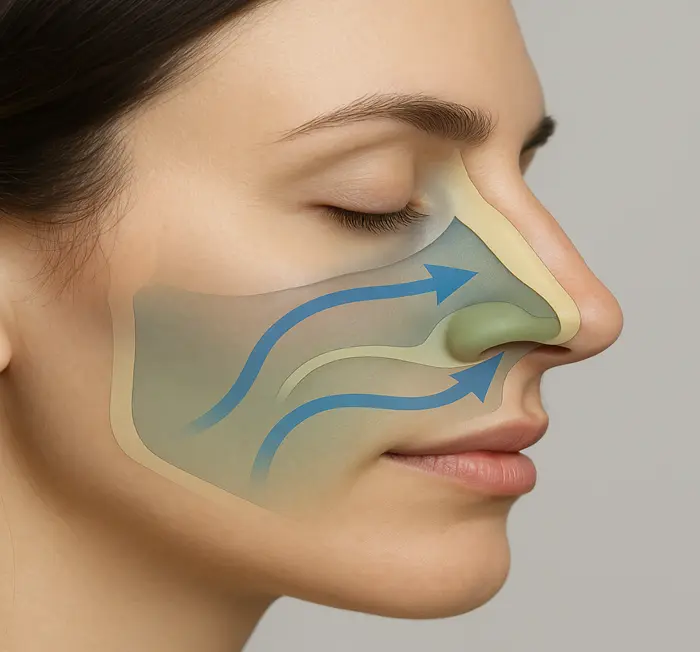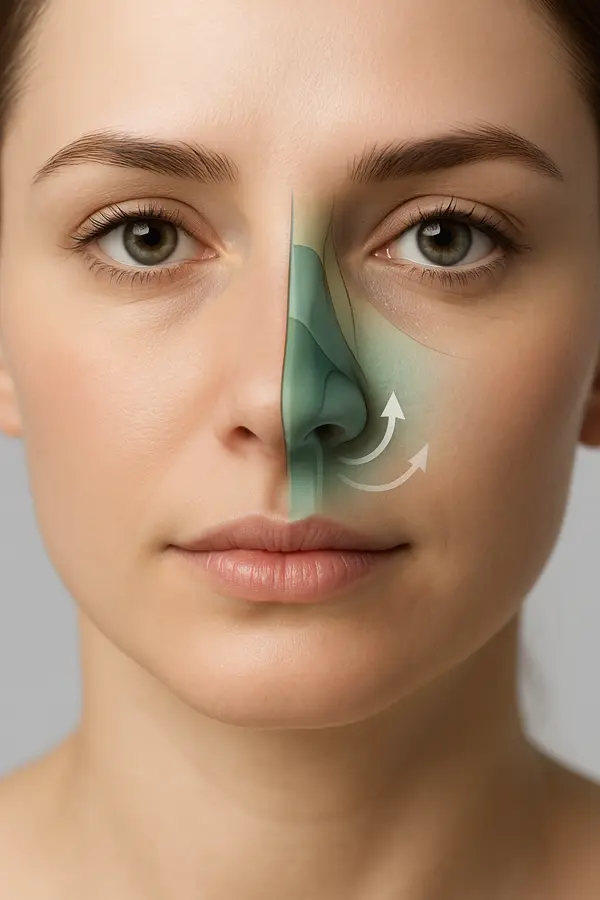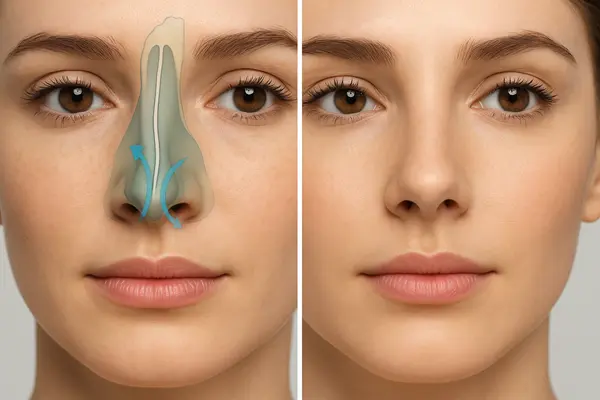Sleep apnea affects millions of people worldwide, disrupting sleep quality and posing serious health risks.
Sleep apnea affects millions of people worldwide, disrupting sleep quality and posing serious health risks. While many associate rhinoplasty primarily with cosmetic nose reshaping, functional nasal surgery can play a significant role in treating certain types of sleep-disordered breathing. Understanding when and how rhinoplasty might help with sleep apnea is crucial for anyone considering this treatment option.
Sleep apnea is a serious sleep disorder characterized by repeated interruptions in breathing during sleep. These pauses, called apneas, can last from seconds to minutes and occur dozens of times per hour. The most common form, obstructive sleep apnea (OSA), happens when throat muscles relax excessively, blocking the airway. Central sleep apnea, less common, occurs when the brain fails to send proper signals to breathing muscles.
Symptoms include loud snoring, gasping during sleep, excessive daytime fatigue, morning headaches, and difficulty concentrating. Left untreated, sleep apnea increases risks of cardiovascular disease, diabetes, and other serious health complications.
Nasal obstruction plays a crucial role in sleep-disordered breathing. When nasal passages are blocked or narrowed, the body compensates by breathing through the mouth. This creates several problems: mouth breathing promotes throat tissue collapse, reduces oxygen intake efficiency, and can worsen sleep apnea symptoms.
Common causes of nasal obstruction include deviated septum, enlarged turbinates, nasal polyps, and structural abnormalities. These conditions force increased effort during breathing, potentially contributing to airway collapse during sleep.


Functional rhinoplasty focuses on improving nasal airflow rather than cosmetic appearance, though both goals can often be achieved simultaneously. Several procedures may help sleep apnea patients:
Septoplasty corrects a deviated nasal septum, the wall dividing the nostrils. When severely crooked, it can significantly obstruct airflow.
Turbinate reduction addresses enlarged nasal turbinates, structures that warm and humidify air but can become swollen and block breathing.
Nasal valve repair strengthens or widens the nasal valve area, the narrowest part of the nasal passage where collapse commonly occurs.
These procedures can improve nasal breathing, reduce mouth breathing during sleep, and potentially decrease sleep apnea severity in appropriate candidates.
While rhinoplasty can be beneficial, it’s typically not a standalone solution for moderate to severe sleep apnea. Common treatments include:
CPAP (Continuous Positive Airway Pressure) remains the gold standard, using pressurized air to keep airways open. However, compliance can be challenging due to discomfort or claustrophobia.
Oral appliances reposition the jaw and tongue to maintain airway openness. They’re often preferred for mild to moderate cases but may cause dental issues long-term.
Lifestyle modifications including weight loss, sleep position changes, and avoiding alcohol can significantly improve symptoms.
Rhinoplasty works best when combined with other treatments or for patients whose sleep apnea is primarily related to nasal obstruction.
Ideal candidates for functional rhinoplasty include patients with:
● Documented nasal obstruction contributing to sleep apnea
● Mild to moderate sleep apnea severity
● CPAP intolerance due to nasal breathing difficulties
● Failed conservative treatments
A thorough evaluation by both sleep medicine specialists and ENT surgeons is essential to determine candidacy.

Realistic expectations are crucial. While rhinoplasty can improve nasal breathing and reduce sleep apnea symptoms, it rarely cures moderate to severe cases completely. Studies show approximately 60-70% of patients experience some improvement in sleep apnea metrics following functional nasal surgery.
Recovery typically involves 1-2 weeks of nasal congestion, with full healing taking several months. Most patients notice gradual breathing improvements as swelling subsides.
Like any surgery, rhinoplasty carries risks including bleeding, infection, scarring, and incomplete symptom resolution. Some patients may experience temporary worsening of nasal congestion during initial healing.
Cost considerations are important, as insurance coverage varies depending on medical necessity documentation and severity of symptoms.
A: Rhinoplasty alone rarely cures sleep apnea but can significantly improve symptoms, especially when nasal obstruction is a primary contributing factor.
A: Initial improvements may be noticed within 2-4 weeks, with continued enhancement over 3-6 months as healing progresses.
A: Never discontinue CPAP without consulting your sleep physician. Post-surgery sleep studies determine if treatment modifications are appropriate.
A: Functional rhinoplasty for documented sleep apnea is often covered, but pre-authorization and thorough documentation are typically required.
A: Other treatment options remain available, including CPAP, oral appliances, or additional surgical procedures targeting different airway areas.
Areas of Expertise

"Rhinoplasty offers an aesthetic and functional appearance by providing facial harmony."
"Rhinoplasty offers an aesthetic and functional appearance by providing facial harmony."
Detailed Info"Sinusitis is a painful condition caused by inflammation of the sinuses around the nose."
"Sinusitis is a painful condition caused by inflammation of the sinuses around the nose."
Detailed Info"Tonsil diseases are conditions that cause infection and swelling in the throat."
"Tonsil diseases are conditions that cause infection and swelling in the throat."
Detailed Info"Adenoids in children are enlarged lymphoid tissue that can cause nasal congestion."
"Adenoids in children are enlarged lymphoid tissue that can cause nasal congestion."
Detailed Info"Botulinum Toxin provides a youthful and smooth appearance on the face by reducing wrinkles."
"Botulinum Toxin provides a youthful and smooth appearance on the face by reducing wrinkles."
Detailed Info"In children, otitis media can cause earache and hearing problems."
"Facial rejuvenation with non-surgical methods reduces wrinkles and revitalizes the skin."
"Facial rejuvenation with non-surgical methods reduces wrinkles and revitalizes the skin."
Detailed Info"Sleep apnea is a disorder that causes breathing pauses during sleep."
At Dr. Osman Halit Çam’s clinic, we offer internationally recognized, patient-centered care with cutting-edge techniques in modern rhinoplasty and facial aesthetics.
From consultation to recovery, our mission is to provide personalized treatment in a safe, comfortable, and world-class medical environment.
Health innovations, treatment processes, and the latest news about our clinic are shared here.
A Comprehensive Guide to Rhinoplasty Correction Nose Job for Crooked Nose Nose job for crooked nose correction, understanding the procedure, benefits, and what to expect can help you make an informed decision about this transformative treatment. Get Info Nose job for crooked nose A crooked nose can significantly impact both your appearance and quality of […]
Your Complete Guide to Rhinoplasty and Piercings Can I Get a Nose Job with Nose Piercing Can I get nose job with nose piercing? This is one of the most common questions patients ask when planning their cosmetic surgery journey. Get Info Can I Get a Nose Job with Nose Piercing? If you’re considering rhinoplasty […]
What Older Adults Need to Know About Nose Surgery Rhinoplasty When You Get Old Rhinoplasty when you get old presents unique considerations that differ significantly from procedures performed on younger patients. Get Info What Older Adults Need to Know About Nose Surgery Rhinoplasty when you get old presents unique considerations that differ significantly from procedures […]
Each of the contents on this site has been prepared for informational purposes. Do not apply any of the treatment methods described on the site without the supervision of a doctor. Otherwise, the site management and Assoc. Prof. will not be responsible in any way for any problems that may arise. Dr. Osman Halit Çam is not responsible.
© 2023 – All Rights Reserved. Assoc. Dr. Osman Halit Cam
Last Updated: 25.07.2025